Exploring The Champagne Vineyards In France
When it comes to wine, there are few regions as well-renowned as the Champagne region of France. Known for its sparkling wine, the region boasts some of the most beautiful vineyards in the world. Exploring

When it comes to wine, there are few regions as well-renowned as the Champagne region of France. Known for its sparkling wine, the region boasts some of the most beautiful vineyards in the world. Exploring these vineyards can be an incredibly enriching experience, providing insights into the history and production of some of the finest wines in the world.
The Champagne region covers an area of approximately 34,000 hectares and contains around 300 different villages. The majority of wine production takes place in the Marne department in the north, with some vineyards also located in the departments of Aube, Haute-Marne, and Aisne.
Visiting the Champagne vineyards can be a truly unique and immersive experience. Many vineyards offer tours and tastings, providing visitors with the opportunity to learn about the history and production of the region\’s wines. Expert guides can help visitors understand the terroir and climate of the region, as well as the cultivation and production techniques used in the creation of those famous bubbles.
One unique aspect of the Champagne region is the strict regulations surrounding the production of the wine. Only sparkling wine produced in the region can legally be called Champagne, and there are strict rules governing the grape varieties and production methods used. This attention to detail has helped make the region world-renowned for its exceptional wines.
When exploring the Champagne vineyards, visitors can expect to see picturesque landscapes of gently sloping hills and neat rows of vines. The region\’s chalky soil also plays a crucial role in the production of Champagne, contributing to the wine\’s unique flavor.
One particularly impressive vineyard in the Champagne region is the Moët & Chandon vineyard, which dates back to 1743. The winery produces over 30 million bottles of Champagne each year and offers tours that provide an in-depth look at the production process. Another notable vineyard is the Veuve Clicquot vineyard, which was founded in 1772 and is famous for its yellow label Champagne.
For those interested in exploring the Champagne vineyards, it\’s important to keep in mind that the best time to visit is during the harvest season, which typically takes place from late August to early September. During this time, visitors can witness the grape-picking process and experience the excitement and energy of the harvest season.
The History of Champagne
The history of Champagne dates back to the 17th century, when the sparkling wine first became popular among European elites. However, it wasn\’t until the 19th century that Champagne became associated with luxury and celebration, thanks in part to the marketing efforts of renowned Champagne houses like Moët & Chandon and Veuve Clicquot.
Today, Champagne is still synonymous with luxury and celebration, often being poured at weddings, New Year\’s Eve parties, and other special occasions. Despite its popularity, Champagne remains a unique and distinctive wine, thanks to the region\’s strict regulations and unique production methods.
Terroir and Climate
One of the key factors that make Champagne such a unique wine is the region\’s terroir and climate. The Champagne region is located northeast of Paris and has a continental climate, with cold winters and warm summers. This climate, combined with the region\’s chalky soil, helps give Champagne its unique flavor profile.
Another important factor in the production of Champagne is the mix of grape varieties used. The majority of Champagne is made from a blend of Chardonnay, Pinot Noir, and Pinot Meunier grapes. Each grape variety plays a critical role in the final flavor and character of the wine.
Production Techniques
Champagne is unique in that it undergoes a second fermentation in the bottle, which creates the wine\’s signature bubbles. This process, known as \”méthode champenoise,\” involves adding yeast and sugar to the wine in the bottle, creating a secondary fermentation that produces carbon dioxide. The wine is then aged for several years before being disgorged, corked, and labeled.
While the production process may seem simple, it is actually incredibly complex and requires careful attention to detail. The production of Champagne is a labor-intensive process that requires skilled artisans with years of experience to create high-quality wines.
The Future of Champagne
The Champagne region has a rich history and a bright future, with the production of sparkling wine continuing to thrive. While climate change and other challenges may present difficulties for producers in the future, the Champagne region remains committed to preserving its traditions and creating high-quality wines for future generations.
As the world\’s love of wine continues to grow, the Champagne region will undoubtedly continue to play a prominent role. Whether you\’re a seasoned wine enthusiast or a casual drinker, exploring the Champagne vineyards is an experience not to be missed.

